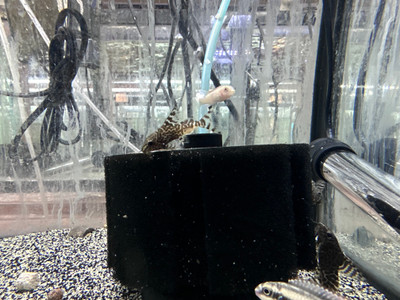Featherfin Catfish (Synodontis eupterus): A Fascinating Freshwater Species
Posted by Max Gandara on on 2nd Jun 2023
Featherfin Catfish (Synodontis eupterus): A Fascinating Freshwater Species
Introduction:
The Featherfin Catfish, scientifically known as Synodontis eupterus, is a
captivating freshwater species that has gained popularity among fish
enthusiasts and hobbyists around the world. Its unique appearance,
behavior, and adaptability make it a sought-after addition to both
community and species-only aquariums. In this article, we will delve
into the fascinating characteristics and care requirements of the
Featherfin Catfish.
Physical Description:
The Featherfin Catfish exhibits a distinct appearance that sets it apart
from other catfish species. It boasts an elongated body, typically
growing up to 12 inches (30 cm) in length. Its coloration can vary,
ranging from light to dark gray, with a series of darker spots scattered
across its body. Its most prominent feature is its large dorsal fin,
which extends to resemble a feather-like shape, giving it the common
name "Featherfin Catfish."
Habitat and Distribution:
Synodontis eupterus is native to various African river systems,
including the Nile, Niger, and Chad basins. These habitats typically
consist of slow-moving or stagnant waters, characterized by dense
vegetation, submerged roots, and rocky structures. The Featherfin
Catfish is a bottom-dweller, preferring to reside among these natural
environments where it can find shelter and ample food sources.
Behavior and Temperament:
Featherfin Catfish are generally peaceful and social creatures. In the
wild, they often congregate in groups, creating a hierarchy within their
social structure. In an aquarium setting, they tend to exhibit similar
behaviors, and it is recommended to keep them in small groups of three
or more to mimic their natural social dynamics. They are nocturnal by
nature, primarily active during the night when they search for food,
utilizing their barbels and specialized sensory organs to locate prey.
Feeding Habits:
In their natural habitat, Featherfin Catfish are omnivorous, feeding on a
varied diet of small invertebrates, insects, crustaceans, and plant
matter. In captivity, they are not overly picky eaters and readily
accept a range of foods. A balanced diet can include high-quality
sinking pellets, frozen or live foods such as bloodworms, brine shrimp,
and occasional vegetable matter. Providing a diverse diet ensures
optimal health and coloration.
Aquarium Setup and Maintenance:
When setting up an aquarium for Featherfin Catfish, it is essential to
recreate their natural habitat as closely as possible. A tank size of at
least 40 gallons (150 liters) is recommended for a small group of these
fish. The substrate should consist of fine sand or small gravel to
mimic the riverbed environment. The presence of driftwood, caves, and
rock formations provides hiding spots and shelter for these catfish.
Maintaining a stable water environment is crucial. The water temperature
should be kept between 75-82°F (24-28°C), with a pH range of 6.5-7.5
and moderate water hardness. Regular water changes and filtration are
essential for maintaining good water quality.
Compatibility:
Featherfin Catfish are generally peaceful and can coexist with a wide
range of fish species, as long as they are not overly aggressive or
prone to fin-nipping. Suitable tankmates include peaceful community fish
like tetras, rasboras, dwarf cichlids, and other non-aggressive catfish
species. It is advisable to avoid pairing them with significantly
smaller fish that may be mistaken as prey.
Breeding:
Breeding Featherfin Catfish in a home aquarium can be challenging due to
the complexity of their reproductive behavior. These catfish are known
to exhibit brood care, where the males guard the eggs and young fry.

